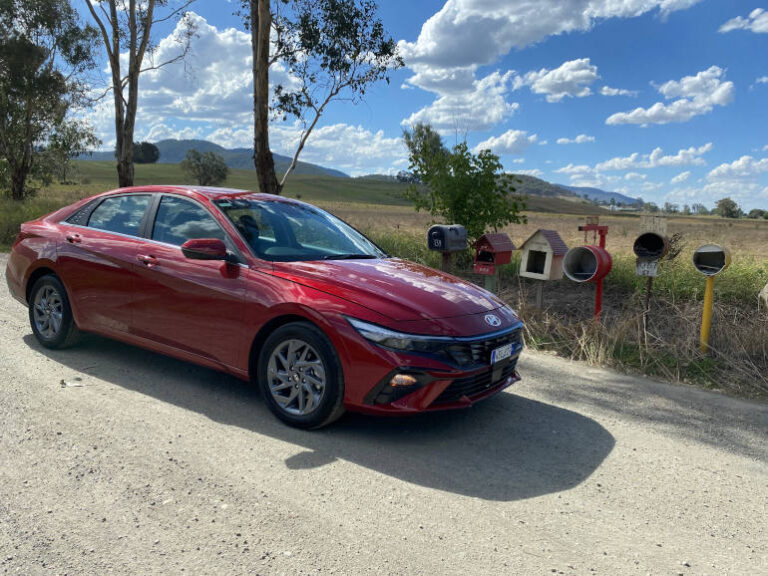Starting at Winton race track and finishing at Adelaide airport…. The logical option would be to drive to Melbourne or Albury, then fly. That’s what the boss man Marc Sibbald did!
But I like to do things in an unconventional way, so I decided to drive the nearly 800km in the new Hyundai i30 Sedan hybrid.
It’s the first ever hybrid i30, and could be considered a great alternative to the Camry hybrid or Corolla sedan hybrid – with a starting price of $33,000 plus on-roads (or $35,990 drive-away), it makes heaps of sense for business and private buyers alike.
With a 1.6-litre four-cylinder petrol engine teamed to an electric motor, which is integrated into the car’s six-speed dual-clutch auto, it is a different drive experience than either of the Toyota models. Not necessarily better — but different.
Petrol-electric hybrid models are known for their fuel efficiency, and the i30 Sedan hybrid claims an impressive 3.8 litres per 100km, making it one of the most on-paper efficient cars on the market. For cars that don’t come with a plug-in option, only the Yaris hybrid is better (3.3L/100km).
The thing is, hybrids do their best work when you’re driving in stop-start scenarios, where you’ll be giving the car’s regenerative braking system its best chance to replenish the battery pack. In traffic you will also call upon the EV driving mode more regularly too, lowering your real fuel use.
The question I wanted to answer with my drive of the i30 Sedan hybrid was whether it would achieve fuel use anywhere near what the sticker claims, but also to see how the powertrain would cope across stretches of major Australian motorways, deviations across rolling open plains, through tiny towns off the beaten track — basically, how it handled stuff it’s not necessarily designed for, or the stuff you may experience if you’re driving an i30 Sedan hybrid as a fleet car as a sales rep or travelling businessperson.
And you know what? It was pretty good.
The hybrid powertrain shuffles between petrol and EV modes when it thinks it’s the best thing to do, even if that means cruising on electric drive at 100km/h. But through the small towns dotted on my route (such as Violet Town, Murchison, Colbinabbin, St Arnaud, Nhill and Tailem Bend), EV mode took over, and it was lovely to hear the sounds of silence.
What’s peculiar about this hybrid is that you can still feel the transmission shifting gears when you’re in EV mode, as the motor is part of the transmission. There’s a 1.32kWh lithium-ion battery pack under the rear seat, which means you don’t need to sacrifice any boot space as a result.
With 474 litres of cargo space, the boot is big enough for a heap of boxes and/or suitcases, and there’s even a space-saver spare wheel under the boot floor.
I didn’t need a spare, thankfully, despite coming across some rough surfaces including roadworks with rough sections, and those single-lane roads in the rural parts that require drivers to drive on the unsealed verges at either side of the paved road when passing — that’s why you’ll see a lot of cars out in these parts with very dirty passenger-side parts.
The comfort on offer was impressive, with mixed surfaces hardly causing an issue as I traversed the countryside. There’s a bit of road noise on rougher sections, but it’s not too intrusive. And I kept entertained for hours thanks to the wireless Apple CarPlay system, which reconnected quickly when I got in and out of the car.

There’s a standout issue with this car – or at least the one I drove – and that’s the safety tech.
With a mix of ADAS systems including auto emergency braking, lane keeping, adaptive cruise control, speed sign recognition and more, it seemingly ticks the box for the safety conscious. But this test car had multiple failures with that technology over my drive, which made maintaining a set speed using adaptive cruise impossible, as it kept cutting all the systems off, repeatedly.
I’d be okay with it cutting out the speed sign system permanently, as it beeps and bongs at you incessantly. That might be handy if you don’t know your surroundings, but if you’re at home and you know your zones, it will frustrate you. And the car doesn’t understand the times when school zones operate, either, so even at 8pm you’ll be warned you’re driving through a 40 zone (or 25 zone, in S.A!).
And if you or your business insist upon an ANCAP rating, you might need to rule this one out — it hasn’t been tested, and may not be in future, either.
Those issues wouldn’t stop me from recommending it, though, because after nearly nine hours behind the wheel (more if you include my regular stops along the way), I got out and didn’t feel sore or overly fatigued.
Oh, and if you’re wondering about the fuel use number? It did 4.5 litres per 100km. Very good for real-world, mainly open-road driving in a hybrid.
If you’d like to watch my video of this road trip, head to my YouTube channel – The Right Car?.






